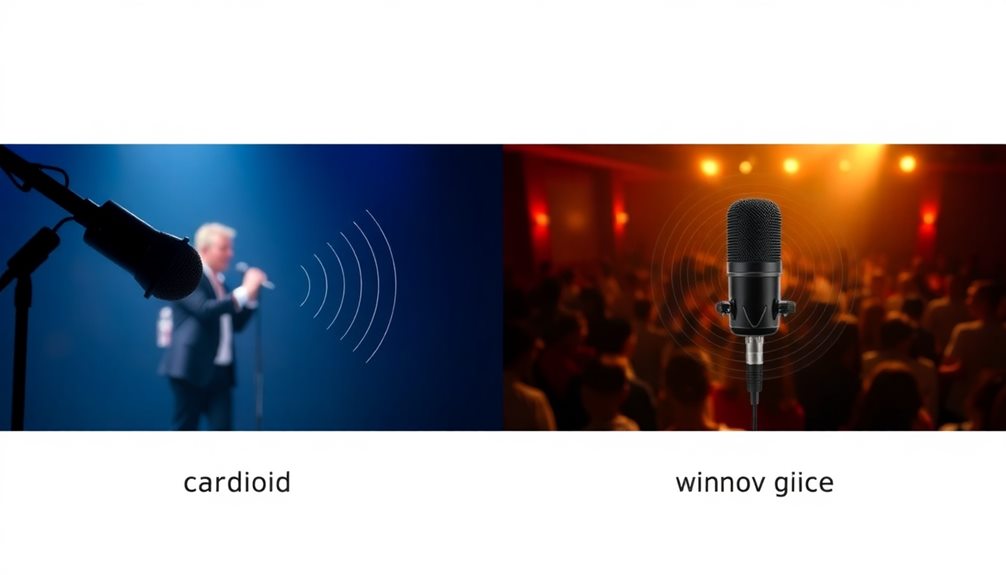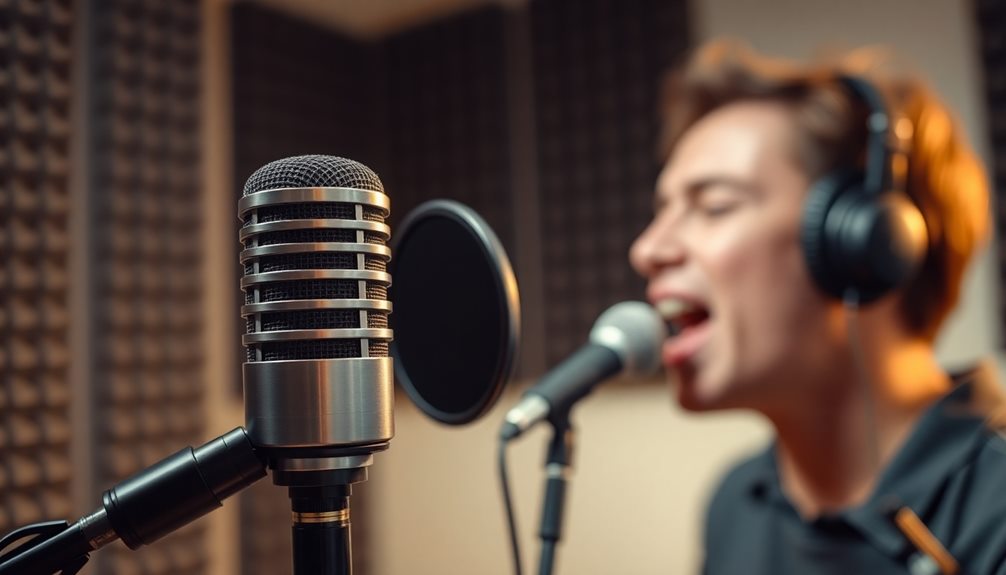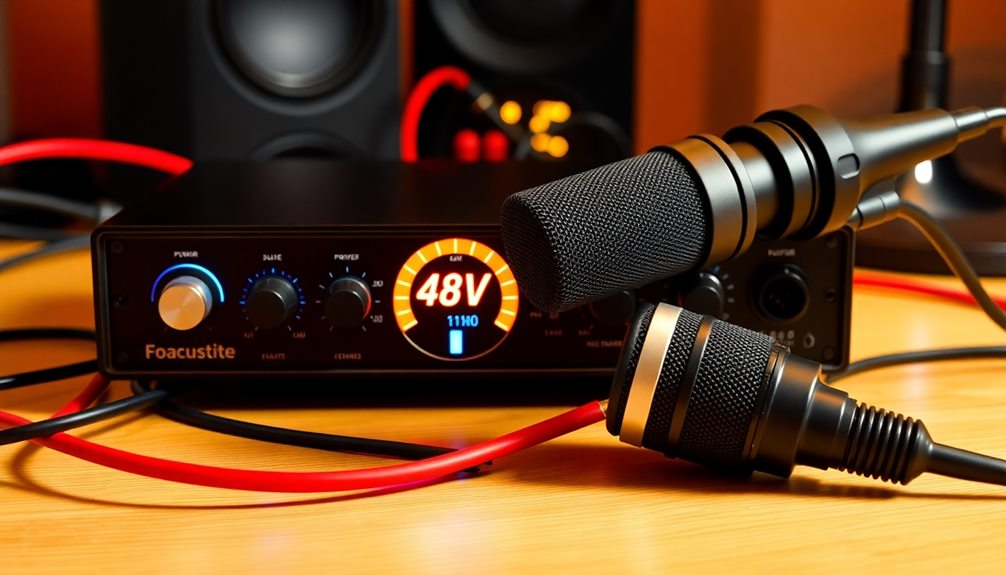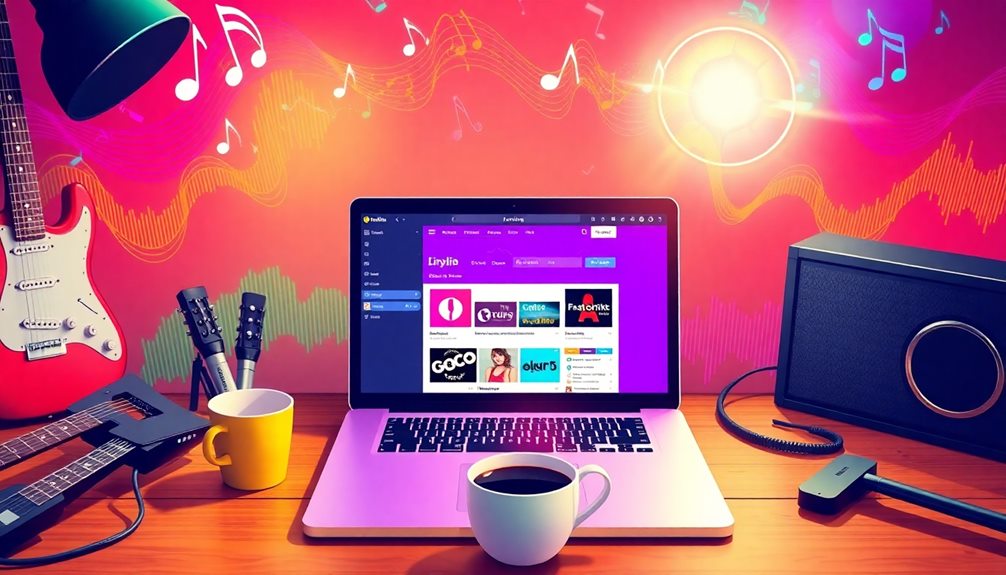Cardioid mics are the ultimate choice for vocals! They capture sound from the front and reduce noise from the sides and back, making your singing shine. With their special heart-shaped design, they also add warmth and richness to your voice, especially when you're close to the mic. This means you can sing louder without worrying about feedback and background noise. Whether you're on stage or in the studio, these mics help your voice stand out. Plus, they're versatile for any performance setting. Isn't that awesome? Keep going, and you'll discover even more fantastic reasons to choose cardioid mics!
Key Takeaways
- Cardioid microphones capture sound primarily from the front, reducing background noise for clearer vocal delivery in live and studio settings.
- The proximity effect enhances low frequencies, adding warmth and richness to vocals, making them sound fuller during performances.
- They provide excellent feedback rejection, allowing for high gain before feedback, ideal for loud environments like concerts.
- Cardioid mics are versatile, suitable for solo performances and effective in isolating vocals from instruments in band settings.
- Common issues such as plosive sounds can be mitigated with pop filters, ensuring optimal vocal clarity while using cardioid mics.
Understanding Cardioid Microphones
Cardioid microphones are essential tools for anyone serious about vocal recordings, whether in the studio or on stage. These mics are specially designed with a heart-shaped pattern that captures sound mainly from the front. This feature helps them reduce noise coming from the sides and back, making your voice shine bright!
One fantastic thing about cardioid microphones is the proximity effect. When you get close to the mic, it boosts the low frequencies in your voice, giving it a warm and rich sound. This is perfect for singers who want their vocals to stand out.
Popular models like the Shure SM58 and AKG P120 are known for their durability and superb sound quality. They're favorites among vocalists, and you'll see them often at concerts and in studios.
Another great benefit is that cardioid microphones excel at rejecting feedback. This means you can crank up the volume without worrying about those annoying squeals.
Benefits of Cardioid Mics for Vocals

Cardioid mics are super cool for vocals because they help block out noise from the sides and back.
This means your voice shines through clearly, making it perfect for singing on stage or recording in a studio.
Plus, they can give your voice a warm and full sound when you get close, making every performance special!
Noise Isolation Advantages
When you're looking to enhance vocal performances, turning to cardioid microphones can greatly boost noise isolation. These microphones are designed to capture sound from the front while minimizing background noise. This means your voice shines through, even in noisy places!
Here's a quick look at how cardioid mics work:
| Feature | Benefit | Why It Matters |
|---|---|---|
| Polar Pattern | Focuses on sound from the front | Reduces unwanted noise |
| Off-Axis Response | Rejects sound from sides and rear | Keeps your vocals clear |
| Gain Before Feedback | Higher resistance to feedback | Great for loud environments |
| Proximity Effect | Boosts low frequencies | Adds warmth to your voice |
| Ideal for Live Shows | Perfect for concerts and events | Guarantees a smooth performance |
With the heart-shaped pickup pattern, cardioid mics help you sound your best. You'll notice less interference from other sounds, making it easier for listeners to focus on your vocals. Whether you're on stage or in the studio, these vocal microphones are a fantastic choice for achieving that crystal-clear sound you desire.
Vocal Clarity Enhancement
With improved noise isolation, cardioid microphones not only enhance vocal clarity but also elevate your overall performance.
These vocal mics are designed to capture sound primarily from the front, thanks to their unique cardioid pickup pattern. This heart-shaped design allows your voice to shine while reducing background noise. You'll notice a big difference in sound quality, especially during live performances or studio recordings.
One of the best features of cardioid mics is the proximity effect. When you sing close to the mic, it adds extra warmth and fullness to your voice. This makes your vocals sound richer and more inviting.
Plus, these mics help cut down on feedback, which can be a huge distraction while performing. By focusing on your voice, cardioid mics guarantee that listeners hear exactly what you want them to hear.
Popular models like the Shure SM58 and AKG P120 have proven their worth in enhancing vocal clarity.
Versatile Performance Applications
Many performers find cardioid microphones to be incredibly versatile for a range of applications, from intimate solo performances to energetic band settings. These mics focus on capturing sound directly from the front, which helps enhance vocal clarity while reducing unwanted background noise. This is especially useful when you're on stage with other sound sources around you.
Here's a quick look at how cardioid mics can shine in different performance situations:
| Performance Type | Benefits of Cardioid Mics | Key Features |
|---|---|---|
| Solo Performances | Clear vocal delivery | Reduces feedback issues |
| Band Settings | Isolates vocals from instruments | Boosts low frequencies close to the mic |
| Recording Sessions | Enhances vocal warmth | Great for various sound sources |
| Live Events | Minimizes background noise | Perfect for noisy environments |
With their heart-shaped polar pattern, cardioid mics effectively isolate your voice, making them a top choice for many performers. You won't have to worry much about feedback issues, either! Whether you're singing softly or belting out high notes, these versatile performance tools can help you shine.
Comparing Cardioid and Omnidirectional Mics

Let's compare cardioid and omnidirectional mics to see which one suits you best!
Cardioid mics focus on sound from the front, making them great for capturing clear vocals while blocking out background noise.
On the other hand, omnidirectional mics pick up sound from all around, which can be fun in some settings, but might bring in unwanted sounds when you're singing.
Polar Pattern Differences
Understanding the polar pattern differences between cardioid and omnidirectional microphones is essential for achieving the best sound quality in any recording or performance.
Cardioid microphones have a heart-shaped polar pattern that picks up sound mostly from the front, which aligns with the principle of enhancing customer interactions by isolating the desired audio source. This makes them perfect for isolating vocals, whether you're on stage or in a studio.
On the other hand, omnidirectional mics capture sound equally from all directions, which can lead to pesky background noise and feedback, especially in busy environments.
One of the biggest advantages of cardioid mics is their greater gain before feedback, making them ideal for live performances with loud stage volumes. Plus, the proximity effect in cardioid microphones boosts low frequencies when you're close to the mic, giving your voice a fuller sound.
In contrast, omnidirectional mics mightn't provide this enhancement as effectively.
Cardioid microphones also offer better channel separation in setups with multiple mics, ensuring each voice stands out clearly.
Background Noise Reduction
When you're performing in a noisy environment, choosing the right microphone can make all the difference in capturing your vocals clearly. Cardioid microphones are perfect for this! Their heart-shaped pickup pattern focuses on sound from the front, reducing background noise from the sides and rear. This means you get to shine, even with distractions around you!
Here's a quick comparison of cardioid and omnidirectional mics:
| Feature | Cardioid Microphones | Omnidirectional Microphones |
|---|---|---|
| Background Noise Reduction | Excellent | Poor |
| Gain-to-Feedback Ratio | High | Low |
| Low-Frequency Response | Enhanced with proximity effect | Limited |
With cardioid mics, you'll enjoy a better gain-to-feedback ratio, allowing you to sing louder without feedback issues. Plus, when you get closer to the mic, the low-frequency response improves, giving your voice a richer sound. In contrast, omnidirectional mics capture sound from all directions, making it harder to focus on your vocals amidst the noise. So, if you want to stand out and be heard, cardioid microphones are the way to go!
Ideal Use Cases
Which microphone should you choose for your specific needs? If you're focused on solo vocal performances or studio recordings, cardioid microphones are your best bet! They capture sound mainly from the front, which means they excel at background noise rejection. This is super helpful when you want your voice to shine without distractions.
In contrast, omnidirectional mics pick up sound from all around. While they're great for capturing group vocals or ambient sounds, they can lead to unwanted noise and leakage, especially in live settings. If you're performing with others, you might find that cardioid mics offer better feedback reduction. They minimize sound pickup from the rear, helping to keep your performance clear and controlled in loud places.
Cardioid mics also boost the bass response when you're close to the mic. This gives your voice a rich and warm tone, perfect for studio recordings.
Recommended Cardioid Microphones for Recording

Finding the right cardioid microphone for recording can greatly enhance your vocal performances. You'll want to take into account a few top options that deliver good sound and performance.
The Shure SM58 is a classic choice, known for its durability and ability to reduce background noise. This makes it great for live shows!
If you're looking for something to use in your home studio, the Rode NT1-A is amazing. It has low self-noise and a wide frequency response, capturing your voice beautifully.
The AKG P120 is another fantastic choice, perfect for both studio recordings and live settings. It captures detailed vocals with minimal noise.
For feedback rejection, check out the Sennheiser E935. It's designed specifically for vocals and offers a natural sound that many pro audio artists love.
Finally, the Audio-Technica AT2020 is super versatile, providing clarity in both home studios and professional environments.
With these recommended cardioid microphones, you'll be on your way to recording amazing vocal tracks. Choose the one that fits your needs, and enjoy the delightful sound it brings!
Common Issues With Cardioid Microphones

Have you ever wondered what common issues might arise when using cardioid microphones? These mics are great for vocals, but they do come with some quirks. One big problem is plosive sounds. When you say words with "p" or "b," it can create bursts of air that distort your voice. Using pop filters can help manage this.
Another challenge is background noise. If you're too far from the mic, it might pick up unwanted sounds, making your recordings less clear.
You also need to watch for feedback issues, especially in live settings. If stage monitors are positioned wrong, the mic can still catch sound from behind, causing annoying feedback.
Then there's the proximity effect. If you get too close, it can boost low frequencies, which may make your voice sound muddy.
Tips for Maximizing Vocal Clarity

To achieve the best vocal clarity with a cardioid microphone, aim to position it about 6 to 12 inches from the vocalist's mouth. This distance helps the microphone pick up the voice clearly while using the proximity effect to boost the low frequencies.
It's crucial to maintain proper mic technique, so encourage singers to stay within this ideal range. This way, they'll avoid off-axis coloration and keep the sound consistent.
Using a high-pass filter (HPF) can also work wonders. It helps cut out low-frequency rumble and background noise, allowing the vocals to shine brighter in the mix.
Plus, don't forget about pop filters! They're fantastic for reducing those pesky plosive sounds that can cause distortion and muddiness, enhancing overall vocal clarity.
Lastly, be mindful of your setup. Position the microphone away from any stage monitors to prevent feedback issues.
Cardioid mics are sensitive to sounds from the front, but they can also pick up unwanted noise from behind. By following these tips, you'll create a fantastic environment for vocal performance, ensuring every note is crystal clear!
Frequently Asked Questions
Why Is Cardioid Good for Vocals?
Cardioid mics are great for vocals because they focus on sound from the front, minimizing background noise. They also enhance warmth and clarity, making your voice stand out in both live performances and recordings.
What Are Cardioid Mics Best For?
Did you know that cardioid mics reduce background noise by up to 20dB? They're best for solo performances, live stages, and noisy venues, ensuring you capture clear, rich vocals while minimizing feedback and distractions.
What Is the Best Mic Pattern for Vocals?
The best mic pattern for vocals is cardioid. It captures sound directly in front while minimizing background noise. You'll enjoy clearer recordings, enhanced vocal warmth, and reduced feedback in both studio and live settings.
What Type of Microphone Is Best for Vocals?
Think of a spotlight on stage; you want to focus on your voice. For vocals, a cardioid microphone's heart-shaped pattern isolates sound, ensuring clarity while minimizing background noise, making it the perfect choice for your performances.
Conclusion
To summarize, choosing a cardioid mic for your vocals is like hitting the bullseye! It helps capture your voice clearly while reducing unwanted noise. With the right cardioid microphone, you can take your recordings to the next level. Remember, practice makes perfect, so don't hesitate to experiment and find what works best for you. You're on your way to creating amazing sounds, and that's something to celebrate! Enjoy making music and let your voice shine!










